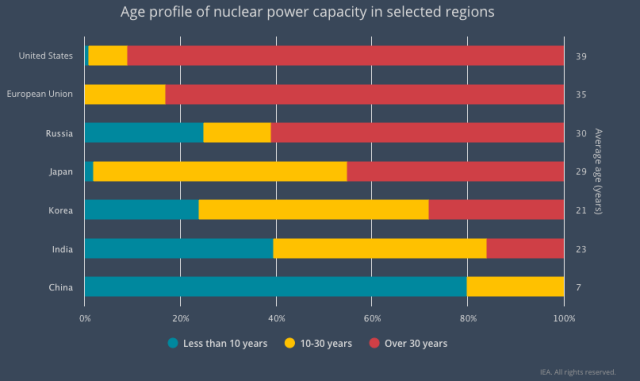A report released today by the International Energy Agency (IEA) warns world leaders that—without support for new nuclear power or lifetime extensions for existing nuclear power plants—the world's climate goals are at risk.
"The lack of further lifetime extensions of existing nuclear plants and new projects could result in an additional four billion tonnes of CO2 emissions," a press release from the IEA noted.
The report is the IEA's first report on nuclear power in two decades, and it paints a picture of low-carbon power being lost through attrition (due to the retirement of aging plants) or due to economics (extremely cheap natural gas as well as wind and solar undercutting more expensive nuclear power for years in some regions).
Around the world, 452 nuclear reactors provided 2,700 terawatt-hours (TWh) of electricity in 2018. This makes nuclear a significant source of low-carbon energy on a global level. While 11.2 gigawatts (GW) of nuclear power were connected to the grid last year, all of the new capacity was located in China or Russia.
US, EU, and Japan
But in advanced economies, the nuclear fleet is much older. Reactors are 35 years old on average, and they are at risk of retirement. "Given their age, plants are beginning to close, with 25 percent of existing nuclear capacity in advanced economies expected to be shut down by 2025."

New nuclear power facilities are few and far between in the US. Two reactor additions in Georgia, for instance, have been hanging on for dear life after Westinghouse declared bankruptcy in 2017. The story is similar in Europe, where Germany has committed to retiring its entire nuclear fleet, and France is considering retiring 14 reactors in the next several years. In Japan, many nuclear reactors were shut down in the aftermath of the Fukushima disaster. Although they're slowly coming back online, adding new nuclear capacity is not a pressing concern.
Rather than commit to the massive capital expenses and regulatory mess of building new reactors, IEA says that extending the life of existing reactors is a somewhat more cost-effective way to keep significant amounts of low-carbon energy on the grid. (Ars recently spoke with a program director at Oak Ridge National Laboratory whose team is working on exactly this issue.)
Still, IEA admits that even extending the life of an existing reactor can be a hard sell in places where electricity is already very cheap. "The estimated cost of extending the operational life of 1GW of nuclear capacity for at least 10 years ranges from $500 million to just over $1 billion depending on the condition of the site," IEA says.
What a bleaker future looks like
With the financial issues of nuclear in mind, the IEA modeled a "Nuclear Fade Case," where nuclear power plants start retiring very quickly, sometimes before their full potential lifetime is up. (This case would look similar to the decline of coal in the US, where natural gas is easily beating out coal on economic merits.)
In the Nuclear Fade Case, "nuclear capacity operating in advanced economies would decline by two-thirds by 2040, from about 280GW in 2018 down to just over 90GW in 2040," the IEA writes.
Obviously, the threat is that nuclear retirements would make it harder to achieve a low-carbon future as nuclear capaciRead More – Source
[contf] [contfnew] 
Ars Technica
[contfnewc] [contfnewc]







